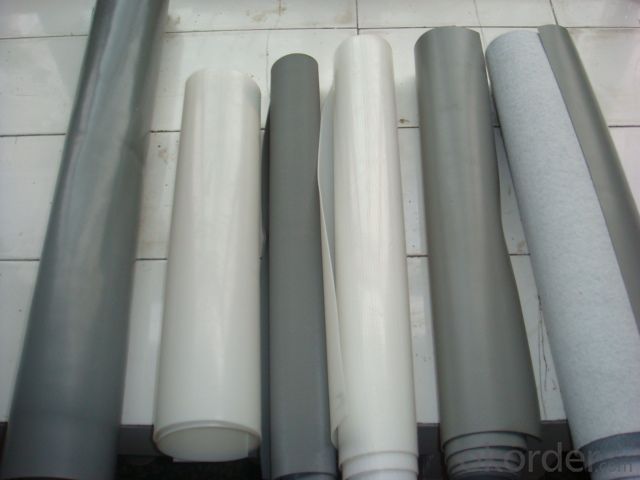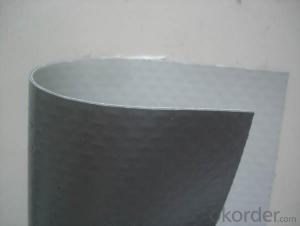PVC Waterproofing Membrane without Compound Layer
- Loading Port:
- China main port
- Payment Terms:
- TT OR LC
- Min Order Qty:
- 5000 m²
- Supply Capability:
- 100000 m²/month
OKorder Service Pledge
OKorder Financial Service
You Might Also Like
Introduction
Polyvinyl Chloride (PVC) waterproof membrane is a new polymer waterproof membrane which is made from polyvinyl chloride resin, and mixed with plasticizer, filler, antioxygen, ultraviolet absorber and other auxiliaries.
Features
1) Excellent aging resistance. Service life of roofing material is over 20 years;
service life of underground material is over 50 years.
2) Root resistant penetration, specially used on planting roof.
3) Welding installation. Joints are solid and environment friendly, no pollution.
4) High tensile strength, good elongation and dimensional stability.
5) Good plasticity, easy and suitable for details installation.
6) Fireproof. Fire extinguished out of the ignition resource.
7) Surface is smooth, no fading and dirty resistant.
Specification
No. | Item | L | N | W | ||||
I | II | I | II | I | II | |||
1 | Tensile strength N/cm ≥ | 100 | 160 | 8 | 12 | 100 | 160 | |
2 | fracture elongation %≥ | 150 | 200 | 200 | 200 | 150 | 200 | |
3 | Dimension Changing at heating %≤ | 1.5 | 1 | 3 | 2 | 1.5 | 1 | |
4 | Foldability at low temperature °C | -20 | -25 | -20 | -25 | -20 | -25 | |
5 | Water tightness | No leakage | No leakage | No Leakage | ||||
6 | Joint shear resistance (N/mm)≥ | 3 | 3 | 6 | ||||
7 | Thermal Ageing treatment | Appearance | no bubble | no bubble | no bubble | |||
Tensile strength changing rate % | ±25 | ±20 | ±25 | ±20 | ±25 | ±20 | ||
Breaking elongation changing rate% | ||||||||
8 | Chemical corrosion resistance | foldability at low temperature °C | -15 | -20 | -15 | -20 | -15 | -20 |
Tensile strength changing rate % | ±25 | ±20 | ±25 | ±20 | ±25 | ±20 | ||
Breaking elongation changing rate% | ||||||||
9 | Artificial climate accelerated aging | foldability at low temperature °C | -15 | -20 | -15 | -20 | -15 | -25 |
Tensile strength changing rate % | ±25 | ±20 | ±25 | ±20 | ±25 | ±20 | ||
Breaking elongation changing rate% | ||||||||
Applications
1) All kinds of roofs, such as steel structure roof, planted roof etc.
2) Underground engineering, such as building basement, subways, tunnels, air raid shelter, etc.
3) Other projects like artificial lake, dam, water reservoir, grain storehouse, etc.
RFQ
1. What is your MOQ?
--Our MOQ is 5000 m2
2. Can you provide sample?
--Yes, samples are in stock. we can offer free sample for you.
3. Do you offer OEM service?
--Yes, we can print customers’ logo on the packaging;
And the size and specification can be produced and design according to your demand.

- Q:Pvc waterproof membrane of the scope of application
- 3, with good weldability, seam hot air welding and the substrate into one; 4, with good water vapor diffusion, condensate easy to release; 5, low temperature flexibility is good, to adapt to the environmental temperature difference is good;
- Q:Are waterproofing membranes easy to install?
- Waterproofing membranes are generally easy to put in place. They can be found in various forms, such as sheets, rolls, or liquid coatings, which allows them to adapt to different surfaces and uses. Typically, the process involves cleaning and preparing the surface, applying the membrane, and ensuring a proper seal. While some technical knowledge and tools may be necessary, manufacturers often provide detailed instructions and guidelines for installation, making it easier for professionals and DIY enthusiasts alike. Furthermore, advancements in technology have resulted in the creation of self-adhesive membranes, which make the installation process even simpler. All in all, with proper preparation and following the correct installation procedures, waterproofing membranes can be installed relatively effortlessly.
- Q:Can a waterproofing membrane be used for tunnels or subway systems?
- Yes, a waterproofing membrane can be used for tunnels or subway systems. It is a common practice to use waterproofing membranes in underground structures to prevent water infiltration and protect the structural integrity of the tunnels or subway systems. These membranes are designed to provide a barrier against water, ensuring the safety and longevity of the underground infrastructure.
- Q:Are waterproofing membranes suitable for exterior use?
- Waterproofing membranes are indeed suitable for use on the exterior. These specific membranes are designed to create a barrier against the infiltration of water and are commonly employed in a range of outdoor applications such as rooftops, balconies, and foundations. They are constructed from durable materials capable of withstanding exposure to harsh weather conditions, UV rays, and temperature fluctuations. By preventing water damage, moisture accumulation, and potential structural problems caused by water infiltration, these membranes offer valuable protection. Furthermore, they can be applied to a variety of surfaces including concrete, metal, and wood, making them highly versatile for different outdoor environments. In summary, waterproofing membranes present a reliable solution for safeguarding exterior surfaces from water damage and extending their lifespan.
- Q:Can a waterproofing membrane be used for storage tanks or containment areas?
- Yes, a waterproofing membrane can be used for storage tanks or containment areas. Waterproofing membranes are designed to provide a barrier against water or other liquid penetration, making them suitable for applications where containment is required. These membranes are typically made from materials such as rubber, PVC, or bitumen, which are known for their water-resistant properties. They can be applied to the interior or exterior surfaces of storage tanks or containment areas to prevent leaks and protect the structures from moisture damage. Additionally, waterproofing membranes can also help to prevent the growth of mold or mildew, ensuring a safe and hygienic environment for stored materials or liquids.
- Q:Can waterproofing membranes be used on foundation walls?
- Yes, waterproofing membranes can be used on foundation walls. These membranes are designed to prevent water penetration and protect the foundation from moisture damage.
- Q:How does a waterproofing membrane perform in areas with chemical exposure or solvents?
- Waterproofing membranes are not specifically designed to resist chemical exposure or solvents. Although they may offer some resistance to certain chemicals, extended exposure to aggressive chemicals can compromise their effectiveness. These chemicals can degrade the membrane material over time, making it brittle, cracked, or ineffective at waterproofing. To improve the performance of a waterproofing membrane in areas with chemical exposure or solvents, it is advisable to use a specialized chemical-resistant membrane. These membranes are made from tested materials that can withstand various chemicals and solvents. They provide a higher level of protection and durability, ensuring long-lasting performance and preventing damage caused by chemical exposure. It is important to choose the appropriate waterproofing membrane based on the specific chemicals and their concentrations present. Seeking guidance from a professional waterproofing contractor or manufacturer can help in selecting the most suitable membrane for the intended application. Regular inspection and maintenance are crucial to monitor the performance of a waterproofing membrane in areas with chemical exposure. Promptly addressing any signs of deterioration, such as cracks, leaks, or discoloration, can prevent further damage and potential water infiltration. Overall, while a waterproofing membrane can offer some protection in areas with chemical exposure or solvents, it is preferable to use a specialized chemical-resistant membrane for superior long-term performance and durability.
- Q:Can a waterproofing membrane be used in areas with high levels of moisture and humidity?
- Yes, a waterproofing membrane can be used in areas with high levels of moisture and humidity. Waterproofing membranes are specifically designed to prevent water penetration and can effectively protect surfaces from water damage even in damp and humid environments.
- Q:Can a waterproofing membrane be used for foundation waterproofing?
- Foundation waterproofing can be achieved by utilizing a waterproofing membrane. This thin layer of material serves the purpose of preventing water penetration into the foundation walls. Typically composed of a flexible material like rubber or plastic, it is applied to the exterior of the foundation. The membrane acts as a barrier, effectively stopping water from seeping into the foundation and causing harm. Installation involves applying a layer of adhesive to the foundation walls and then rolling the membrane onto the adhesive. For a watertight seal, the seams of the membrane are usually sealed using special tape or adhesive. Employing a waterproofing membrane for foundation waterproofing is an effective method of safeguarding the foundation against water damage. It helps to prevent problems such as leaks, cracks, mold growth, and structural damage that can occur due to water infiltration. It is worth noting that while a waterproofing membrane is a valuable component of foundation waterproofing, it should not be the sole measure taken. Proper drainage, grading, and foundation construction are also crucial factors in preventing water damage. Therefore, consulting with a professional to determine the optimal combination of waterproofing methods for your specific foundation is strongly recommended.
- Q:Are waterproofing membranes resistant to rodent and insect infestation?
- Waterproofing membranes are not typically designed with specific resistance against rodent and insect infestation in mind. While their main purpose is to safeguard structures from water damage, they might offer some degree of protection against pests. However, if rodents or insects are determined to invade a particular area, they can discover ways to circumvent or harm the membrane. To effectively prevent infestation by rodents and insects, it is recommended to adopt additional measures. These include sealing any gaps or cracks in the building, employing appropriate pest control methods, and adhering to good hygiene practices. By doing so, a more comprehensive approach can be achieved in keeping pests out and safeguarding the structure's integrity.
1. Manufacturer Overview |
|
|---|---|
| Location | |
| Year Established | |
| Annual Output Value | |
| Main Markets | |
| Company Certifications | |
2. Manufacturer Certificates |
|
|---|---|
| a) Certification Name | |
| Range | |
| Reference | |
| Validity Period | |
3. Manufacturer Capability |
|
|---|---|
| a)Trade Capacity | |
| Nearest Port | |
| Export Percentage | |
| No.of Employees in Trade Department | |
| Language Spoken: | |
| b)Factory Information | |
| Factory Size: | |
| No. of Production Lines | |
| Contract Manufacturing | |
| Product Price Range | |
Send your message to us
PVC Waterproofing Membrane without Compound Layer
- Loading Port:
- China main port
- Payment Terms:
- TT OR LC
- Min Order Qty:
- 5000 m²
- Supply Capability:
- 100000 m²/month
OKorder Service Pledge
OKorder Financial Service
Similar products
New products
Hot products
Related keywords



























